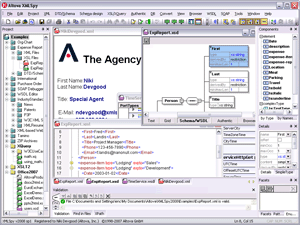XSLT is a language for transforming XML documents into other XML documents, or other formats such as HTML for web pages, plain text or XSL Formatting Objects, which may subsequently be converted to other formats, such as PDF, PostScript and PNG. XSLT 1.0 is widely supported in modern web browsers.
An XML editor is a markup language editor with added functionality to facilitate the editing of XML. This can be done using a plain text editor, with all the code visible, but XML editors have added facilities like tag completion and menus and buttons for tasks that are common in XML editing, based on data supplied with document type definition (DTD) or the XML tree.

JDeveloper is a freeware IDE supplied by Oracle Corporation. It offers features for development in Java, XML, SQL and PL/SQL, HTML, JavaScript, BPEL and PHP. JDeveloper covers the full development lifecycle from design through coding, debugging, optimization and profiling to deploying.
eXist-db is an open source software project for NoSQL databases built on XML technology. It is classified as both a NoSQL document-oriented database system and a native XML database. Unlike most relational database management systems (RDBMS) and NoSQL databases, eXist-db provides XQuery and XSLT as its query and application programming languages.
An XML database is a data persistence software system that allows data to be specified, and sometimes stored, in XML format. This data can be queried, transformed, exported and returned to a calling system. XML databases are a flavor of document-oriented databases which are in turn a category of NoSQL database.
In computing and data management, data mapping is the process of creating data element mappings between two distinct data models. Data mapping is used as a first step for a wide variety of data integration tasks, including:

XMLSpy is a proprietary XML editor and integrated development environment (IDE) developed by Altova. XMLSpy allows developers to create XML-based and Web services applications using technologies such as XML, JSON, XBRL, XML Schema, XSLT, XPath, XQuery, WSDL and SOAP.
Founded in 1992, Altova is a commercial software development company with headquarters in Beverly, MA, United States and Vienna, Austria that produces integrated XML, JSON, database, UML, and data management software development tools.

The Oxygen XML Editor is a multi-platform XML editor, XSLT/XQuery debugger and profiler with Unicode support. It is a Java application, so it can run in Windows, Mac OS X, and Linux. It also has a version that can run as an Eclipse plugin.
Entity Framework (EF) is an open source object–relational mapping (ORM) framework for ADO.NET. It was originally shipped as an integral part of .NET Framework. Starting with Entity Framework version 6, it has been delivered separately from the .NET Framework.

Microsoft Visual Studio is an integrated development environment (IDE) from Microsoft. It is used to develop computer programs, as well as websites, web apps, web services and mobile apps. Visual Studio uses Microsoft software development platforms such as Windows API, Windows Forms, Windows Presentation Foundation, Windows Store and Microsoft Silverlight. It can produce both native code and managed code.
JBoss Tools is a set of Eclipse plugins and features designed to help JBoss and JavaEE developers develop applications. It is an umbrella project for the JBoss developed plugins that will make it into JBoss Developer Studio.
XPath is a query language for selecting nodes from an XML document. In addition, XPath may be used to compute values from the content of an XML document. XPath was defined by the World Wide Web Consortium (W3C).
JBoss Developer Studio (JBDS) is a development environment created and currently developed by JBoss and Exadel.
In software development XRX is a web application architecture based on XForms, REST and XQuery. XRX applications store data on both the web client and on the web server in XML format and do not require a translation between data formats. XRX is considered a simple and elegant application architecture due to the minimal number of translations needed to transport data between client and server systems. The XRX architecture is also tightly coupled to W3C standards to ensure XRX applications will be robust in the future. Because XRX applications leverage modern declarative languages on the client and functional languages on the server they are designed to empower non-developers who are not familiar with traditional imperative languages such as JavaScript, Java or .Net.
XQuery is a query and functional programming language that queries and transforms collections of structured and unstructured data, usually in the form of XML, text and with vendor-specific extensions for other data formats. The language is developed by the XML Query working group of the W3C. The work is closely coordinated with the development of XSLT by the XSL Working Group; the two groups share responsibility for XPath, which is a subset of XQuery.
Liquid XML Studio IDE is a Windows based XML editor and XML data binding toolkit. It includes graphical editors for authoring XML, XML Schema, WSDL, XSLT and HTML. It also includes user interface extension to Microsoft Visual Studio through the Visual Studio Industry Partner (VSIP) program.

An XML transformation language is a programming language designed specifically to transform an input XML document into an output document which satisfies some specific goal.

Business Intelligence Markup Language (Biml) is a domain-specific XML dialect for defining business intelligence (BI) assets. Biml authored BI assets can currently be used by the BIDS Helper add-on for Microsoft SQL Server Business Intelligence Development Studio (BIDS) and the Varigence Mist integrated development environment; both tools translate Biml metadata into SQL Server Integration Services (SSIS) and SQL Server Analysis Services (SSAS) assets for the Microsoft SQL Server platform. However, emitters can be created to compile Biml for any desired BI platform.